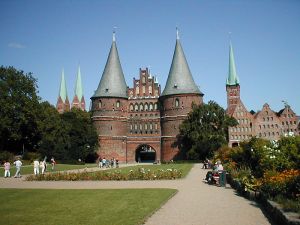 Much of early Gothic architecture is reminiscent of the French style, as seen in the Cologne Cathedral, which was modeled after the one at Amiens. Gradually, however, we can see stone being replaced by bricks.
Much of early Gothic architecture is reminiscent of the French style, as seen in the Cologne Cathedral, which was modeled after the one at Amiens. Gradually, however, we can see stone being replaced by bricks.
This trend started at the northern German city of Lübeck, which was once deemed the “capital of the Hanseatic League,” which might explain why building took such form there. It not only had the economic resources, but also possessed a very pious and civic community. Churches, town halls, and the famous city gates were all needed to be built, and the lack of stone availability forced the Germans to use clay instead.
As the use of baked red brick in Northern Europe dates from the 12th century, the oldest such buildings are classified as the Brick Romanesque. In the 16th century, Brick Gothic was superseded by Brick Renaissance architecture.
Brick Gothic is characterized by the lack of figural architectural sculpture, widespread in other styles of Gothic architecture; and by its creative subdivision and structuring of walls, using built ornaments and the color contrast between red bricks, glazed bricks and white lime plaster.

